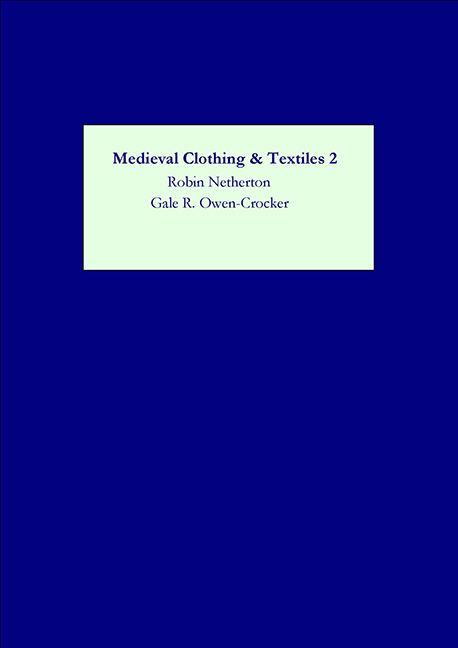Book contents
- Frontmatter
- Contents
- Illustrations page
- Tables
- Contributors
- Preface
- 1 Dress and Accessories in the Early Irish Tale 'The Wooing Of Becfhola”
- 2 The Embroidered Word: Text in the Bayeux Tapestry
- 3 “De Fil d'Or et de Soie”: Making Textiles in Twelfth-Century French Romance
- 4 Biffes, Tiretaines, and Aumonières: The Role of Paris in the International Textile Markets of the Thirteenth and Fourteenth Centuries
- 5 'Clothing Themselves in Acres”: Apparel and Impoverishment in Medieval and Early Modern England
- 6 'Ye Shall Have It Cleane”: Textile Cleaning Techniques in Renaissance Europe
- 7 Fleas, Fur, and Fashion: Zibellini as Luxury Accessories of the Renaissance
- 8 The Matron Goes to the Masque: The Dual Identity of the English Embroidered Jacket
- Recent Books of Interest
- Index
6 - 'Ye Shall Have It Cleane”: Textile Cleaning Techniques in Renaissance Europe
Published online by Cambridge University Press: 14 February 2019
- Frontmatter
- Contents
- Illustrations page
- Tables
- Contributors
- Preface
- 1 Dress and Accessories in the Early Irish Tale 'The Wooing Of Becfhola”
- 2 The Embroidered Word: Text in the Bayeux Tapestry
- 3 “De Fil d'Or et de Soie”: Making Textiles in Twelfth-Century French Romance
- 4 Biffes, Tiretaines, and Aumonières: The Role of Paris in the International Textile Markets of the Thirteenth and Fourteenth Centuries
- 5 'Clothing Themselves in Acres”: Apparel and Impoverishment in Medieval and Early Modern England
- 6 'Ye Shall Have It Cleane”: Textile Cleaning Techniques in Renaissance Europe
- 7 Fleas, Fur, and Fashion: Zibellini as Luxury Accessories of the Renaissance
- 8 The Matron Goes to the Masque: The Dual Identity of the English Embroidered Jacket
- Recent Books of Interest
- Index
Summary
“The first part [of this tract] deals with the clothing of people in holy orders, which are vestment and gown and alb and surplice, and how many ells of fabric one requires for them and how one refreshes the color of velvet and silk and wool fabrics which have lost their color. The second part speaks of painting silver and gold and of all colors, and of how one draws pictures upon paper, and what is required for this.”
Thus opens the text of the manuscript known as the Nuremberg Kunstbuch, written as an instructional manual for the sisters of the convent of St. Catherine's in Nuremburg, Germany. The manuscript, consisting of sixty-nine parchment folios in Gothic halfcursive, was bound into book form in the last half of the fifteenth century. It was apparently in the possession of lay sister Margaret Bindterin in 1596, the year St. Catherine's was dissolved by order of the Nuremberg council. When she died in the following year, the Kunstbuch was handed over to the Nuremberg Stadtbibliothek, which had earlier received the other manuscripts that had belonged to the convent.
The manuscript is a wide-ranging document designed to help the nuns in the course of their daily work of making the rich liturgical vestments worn by Dominican priests, cleaning a variety of fine textiles, and painting and gilding both manuscripts and cloth. The convent's scriptorium was quite active during the last half of the fifteenth century, and it is very possible that this treatise was copied in its entirety from one or more of the books brought to the convent by the daughters of well-to-do townsfolk, or from copies of older manuscripts already in its library.
THE KUNSTBUCH's FABRIC CARE RECIPES
The Kunstbuch contains a total of twelve recipes for cleaning undergarments, removing spots, and restoring the color of faded garments. Table 6.1 presents the original texts of these recipes, with translations. Although small in number, these recipes offer a glimpse into the particular issues that the sisters may have faced in repairing and cleaning their store of garments.
Although not a topic commonly addressed in the great philosophical treatises of the time, the care of fabric and textiles was a ubiquitous concern during the fifteenth and sixteenth centuries.
- Type
- Chapter
- Information
- Medieval Clothing and Textiles 2 , pp. 101 - 120Publisher: Boydell & BrewerPrint publication year: 2006
- 2
- Cited by



